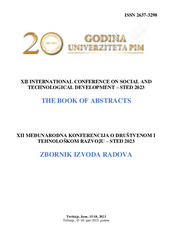Приказ основних података о документу
Reductive removal of hexavalent chromium in aqueous solution by magnetic amino-functionalized polymer nanocomposite
| dc.creator | Suručić, Ljiljana T. | |
| dc.creator | Sandić, Zvjezdana | |
| dc.creator | Stanković, Aljoša | |
| dc.creator | Janjić, Goran | |
| dc.creator | Tadić, Tamara | |
| dc.creator | Marković, Bojana | |
| dc.creator | Onjia, Antonije | |
| dc.date.accessioned | 2023-12-04T14:47:29Z | |
| dc.date.available | 2023-12-04T14:47:29Z | |
| dc.date.issued | 2023 | |
| dc.identifier.issn | 2637-3298 | |
| dc.identifier.uri | https://cer.ihtm.bg.ac.rs/handle/123456789/7000 | |
| dc.description.abstract | The contamination of water with chromium is a global issue that is especially severe in developing countries with intensive mining and heavy industry (South Africa, Pakistan, and India) [1,2]. Trivalent Cr(III) and hexavalent Cr(VI) are the most common forms found in effluent water. Whereas trivalent chromium is a micronutrient (25–35 g/day) involved in the metabolism of lipids and carbohydrates [3,4], hexavalent chromium is exceedingly toxic, teratogenic, and mutagenic. Particularly concerning are its high solubility in water, mobility in detritus, and potential for bioaccumulation in living tissues. Due to these factors, hexavalent chromium has been the subject of numerous studies, especially its removal from effluent [5,6]. These studies have demonstrated that sorption is a highly effective and relatively simple technique for chromium removal from wastewater. In terms of this, magnetic heavy metals nanosorbents derived from inorganic compounds and polymers [7-9] are incredibly intriguing, because they could have been readily extracted from the mixture using an external magnetic field. The sorption investigation of hexavalent chromium in aqueous solutions on the magnetic aminofunctionalized polymer nanocomposite based on glycidyl methacrylate, m-PGMA revealed its highly selectivity and efficiency. [10,11]. The binding mechanism of hexavalent chromium ions onto m-PGMA was investigated using kinetic, equilibrium, and thermodynamic experiments as well as molecular modeling techniques (theoretical quantum-chemical calculations) [12-15]. It was observed that the process occurs in two phases. In the first phase, electrostatic interactions attract hexavalent chromium ions to the surface of the sorbent via the active sites (amino and APTMS groups). Cr(VI) is then converted to Cr(III) ions, which can coordinate with amino or hydroxyl groups on the surface of the sorbent [16]. The trivalent chromium ions that persist in the solution or on the surface of the sorbent are less hazardous than the initial hexavalent form. The application of m-PGMA sorbent enables the transformation of the toxic form of chromium into a less hazardous form, which is significant due to the possibility of sorbent regeneration and the subsequent processing of the solution following sorption. | sr |
| dc.language.iso | en | sr |
| dc.publisher | Banja Luka, Republic of Srpska, B&H : University PIM | sr |
| dc.relation | info:eu-repo/grantAgreement/MESTD/inst-2020/200026/RS// | sr |
| dc.relation | info:eu-repo/grantAgreement/MESTD/inst-2020/200135/RS// | sr |
| dc.rights | openAccess | sr |
| dc.rights.uri | https://creativecommons.org/licenses/by/4.0/ | |
| dc.source | The Book of Abstracts - XII International conference on Social and Technological Development – STED 2023, June, 15-18, 2023, Trebinje / Zbornik izvoda radova - XII međunarodna konferencija o društvenom i tehnološkom razvoju – STED 2023, 15-18. juni 2023. godine, trebinje | sr |
| dc.subject | hexavalent chromium | sr |
| dc.subject | sorption | sr |
| dc.subject | magnetic polymer nanocomposite | sr |
| dc.title | Reductive removal of hexavalent chromium in aqueous solution by magnetic amino-functionalized polymer nanocomposite | sr |
| dc.type | conferenceObject | sr |
| dc.rights.license | BY | sr |
| dc.citation.spage | 118 | |
| dc.citation.epage | 120 | |
| dc.citation.rank | M34 | |
| dc.citation.rank | M34 | |
| dc.identifier.rcub | https://hdl.handle.net/21.15107/rcub_cer_7000 | |
| dc.identifier.fulltext | http://cer.ihtm.bg.ac.rs/bitstream/id/27677/bitstream_27677.pdf | |
| dc.type.version | publishedVersion | sr |


